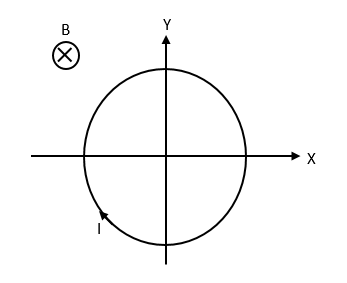
A conducting loop carrying a current is placed in a uniform magnetic field pointing into the plane of the paper as shown in the figure. The loop will have a tendency to:

A) Conduct
B) Expand
C) Move towards +ve x-axis
D) Move towards -ve x-axis
Answer
139.2k+ views
Hint: If a current carrying conductor is placed in an external magnetic field then the conductor experiences a force. The direction of the force is given by Fleming's left hand rule. The magnetic field, the direction of the current and the force due to the magnetic field are mutually perpendicular to each other.
Complete solution:
Fleming’s left hand rule states that whenever a current carrying conductor is kept in a magnetic field a force is experienced by the conductor due to the magnetic field. When the forefinger, middle finger and thumb are mutually perpendicular to each other and if the forefinger represents the direction of the magnetic field and the middle finger points the direction of the current in the conductor, then the thumb is pointing the direction of force or motion of the conductor experienced due to the presence of the magnetic field. The question here mentions that the magnetic field is uniform.
The current carrying current loop in magnetic force experiences zero force. Since it experiences zero force there won’t be any translational motion experienced by the current loop. Thus, we can eliminate the options (C) and (D) which state the motion of the current loop in the positive or negative x-axis. Now we use Fleming's left hand rule. The question states the magnetic field pointing perpendicular to the plane of the paper in the inwards direction represented by the forefinger. Also the diagram shows that the current is flowing clockwise which is represented by the middle finger. Then using Fleming's left hand rule we get that the thumb represents the direction of the force which at every point in the loop is directed radially outwards.
As the force at every point directs radially outwards, thus, the loop will have a tendency to expand.
Therefore, option (B) is the correct answer.
Note: Do not confuse between Fleming's left hand rule and Fleming’s right hand rule. Fleming's right hand rule is used to find the direction of the current induced by the conductor due to the force applied in a given magnetic field whereas Fleming’s left hand rule is used to find the direction of the force experienced by the current carrying conductor kept in the magnetic field.
Complete solution:
Fleming’s left hand rule states that whenever a current carrying conductor is kept in a magnetic field a force is experienced by the conductor due to the magnetic field. When the forefinger, middle finger and thumb are mutually perpendicular to each other and if the forefinger represents the direction of the magnetic field and the middle finger points the direction of the current in the conductor, then the thumb is pointing the direction of force or motion of the conductor experienced due to the presence of the magnetic field. The question here mentions that the magnetic field is uniform.
The current carrying current loop in magnetic force experiences zero force. Since it experiences zero force there won’t be any translational motion experienced by the current loop. Thus, we can eliminate the options (C) and (D) which state the motion of the current loop in the positive or negative x-axis. Now we use Fleming's left hand rule. The question states the magnetic field pointing perpendicular to the plane of the paper in the inwards direction represented by the forefinger. Also the diagram shows that the current is flowing clockwise which is represented by the middle finger. Then using Fleming's left hand rule we get that the thumb represents the direction of the force which at every point in the loop is directed radially outwards.
As the force at every point directs radially outwards, thus, the loop will have a tendency to expand.
Therefore, option (B) is the correct answer.
Note: Do not confuse between Fleming's left hand rule and Fleming’s right hand rule. Fleming's right hand rule is used to find the direction of the current induced by the conductor due to the force applied in a given magnetic field whereas Fleming’s left hand rule is used to find the direction of the force experienced by the current carrying conductor kept in the magnetic field.
Recently Updated Pages
Young's Double Slit Experiment Step by Step Derivation

How to find Oxidation Number - Important Concepts for JEE

How Electromagnetic Waves are Formed - Important Concepts for JEE

Electrical Resistance - Important Concepts and Tips for JEE

Average Atomic Mass - Important Concepts and Tips for JEE

Chemical Equation - Important Concepts and Tips for JEE

Trending doubts
JEE Main 2025 Session 2: Application Form (Out), Exam Dates (Released), Eligibility, & More

JEE Main 2025: Derivation of Equation of Trajectory in Physics

A point charge + 20mu C is at a distance 6cm directly class 12 physics JEE_Main

Learn About Angle Of Deviation In Prism: JEE Main Physics 2025

Electric Field Due to Uniformly Charged Ring for JEE Main 2025 - Formula and Derivation

JEE Main 2025: Conversion of Galvanometer Into Ammeter And Voltmeter in Physics

Other Pages
JEE Advanced Marks vs Ranks 2025: Understanding Category-wise Qualifying Marks and Previous Year Cut-offs

Degree of Dissociation and Its Formula With Solved Example for JEE

Electric field due to uniformly charged sphere class 12 physics JEE_Main

Dual Nature of Radiation and Matter Class 12 Notes: CBSE Physics Chapter 11

Formula for number of images formed by two plane mirrors class 12 physics JEE_Main

A conducting loop carrying a current is placed in a class 12 physics JEE_Main




